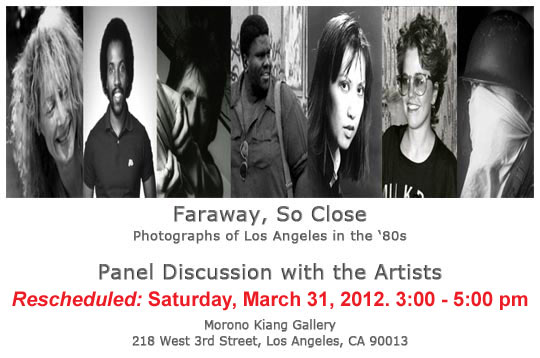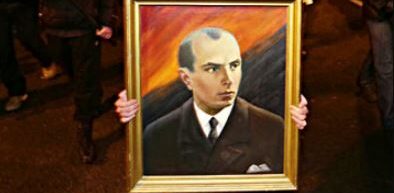Faraway, So Close: ’80s L.A. Photos

I will be exhibiting six never before shown photos at Faraway, So Close, a group exhibition of photographs on the theme of Los Angeles as it existed between the years 1980 and 1989. Running from February 4, 2012, to March 31, 2012 at the Morono Kiang Gallery in downtown Los Angeles, the exhibit also features works by Sara Jane Boyers, Edward Colver, Willie Middlebrook, Ann Summa, May Sun, and Richard Wyatt.
Some participants in the exhibit are celebrated photographers known for capturing the visage of L.A. with their gifted camerawork. Others – this would include me – are more interested in painting the city’s diversity on canvas, using photography only as an optional extra tool in the artistic process. What unifies these two schools in Faraway, So Close, is an intention to catch something of the truth about life in Los Angeles.
I have always been interested in the connection that exists between drawing, painting, and photography, ever since I discovered as a pre-teen that the 17th century Dutch painter Johannes Vermeer quite possibly used a camera obscura as a tool in creating his fabulous oil paintings.
As a teenager I was enthralled, not by the world of art photographers, but by the efforts of documentarians like Dorothea Lange, Robert Capa, and Walker Evans. Their photos from the 1930’s depicting real world events and individuals clearly indicated to me that art was about more than just aesthetics, it had a social purpose as well. When I discovered the paintings of Ben Shahn, one of America’s premiere social realist painters from the 1930s, I learned he was also a photographer that used a 35mm Leica to capture the realities of New York’s working poor. That he based his artworks upon his photographs was an inspiration to me, a fact that helped guide me to the camera as an essential tool in my work as a visual artist. As I conducted further research into the relationship between painting and photography, I was impressed by the views of the Mexican Muralist David Alfaro Siqueiros, who wrote the following in the late 1930’s:
“I consider that, in their escape from reality, the modern painters of the Paris school committed the greatest blunder in the history of art, especially when a mechanical apparatus had just made it possible to capture reality. The photographic camera helped objective art to break out of the dead end in which it found itself; it made possible the advance of realism. The camera is the indispensable tool of a new realism, and without it one cannot even begin to think about the solution of such a problem. The camera established the knowledge of astronomy and of astrophysics. With the help of X-rays, photography gave medicine empirical knowledge of man’s insides. It captures pictures; how then can we, the creators of pictures, ignore or despise it?”
Just as Shahn and Siqueiros used their snapshots as starting points for more complex works, I too have used my photos as source material for drawings and paintings. While I have never regarded myself as a photographer, there is a correlation between my art and the photo. As a figurative realist artist the camera has always provided me with the ability to capture fleeting realities to be studied, interpreted, and built upon in the studio. For me the camera serves as a sketchbook of sorts, it is the means to an end, i.e., extrapolating on the information it gathers in order to create drawings, paintings, and prints that comment on the human condition.

Throughout the late 1970s and 1980s I carried a 35mm camera, using it as a “sketchpad” to keep a record of the ever changing social landscape that is Los Angeles. During that period I took informal photos of everything from L.A.’s explosive punk rock scene (which I was actively engaged in), to the mass protests organized by the peace and anti-Apartheid movements (where I was also involved as an activist). My selected photographs in Faraway, So Close show my participation in, and documentation of, the Central American solidarity network that was such a large part of L.A.’s political landscape in the 1980s.
The Opening Reception for Faraway, So Close takes place on Saturday, February 4, 2012, from 6 to 9 p.m. The Morono Kiang Gallery is located in downtown Los Angeles on the ground floor of the historic Bradbury Building; 218 West 3rd Street, Bradbury Building. Los Angeles, CA 90013 (directions and map). Regular gallery hours are 12 to 6 p.m., Tuesday through Saturday. The exhibit runs until March 31, 2012.
UPDATE/Read the Los Angeles Times review of the Morono Kiang exhibit, Photo File: ‘Faraway So Close’ documents turbulent ’80s in L.A.
Panel Discussion with the artists at the Morono Kiang Gallery
Saturday, March 31, 2012. 3:00 – 5:00 pm
 The Morono Kiang Gallery will host a panel discussion with the artists of Faraway, So Close on Saturday March 31, 2012 from 3:00-5:00 pm. Please join us as artists (shown above) Sara Jane Boyers, Richard Wyatt, Edward Colver, Willie Middlebrook, May Sun, Ann Summa, Mark Vallen, and Shervin Shahbazi (not pictured), recount life in 1980s Los Angeles, talk about their experiences in a changing cultural landscape, and answer questions about their work.
The Morono Kiang Gallery will host a panel discussion with the artists of Faraway, So Close on Saturday March 31, 2012 from 3:00-5:00 pm. Please join us as artists (shown above) Sara Jane Boyers, Richard Wyatt, Edward Colver, Willie Middlebrook, May Sun, Ann Summa, Mark Vallen, and Shervin Shahbazi (not pictured), recount life in 1980s Los Angeles, talk about their experiences in a changing cultural landscape, and answer questions about their work.
The artists in the exhibit were asked to present a personal take on what they were looking at during this particular place and time. As a result, the works presented in the exhibit fulfill the artists’ professional and/or personal objectives. These photographs, taken by artists charged with the task of documenting the cultural life happening around them, provide a glimpse into the city’s recent past from multiple vantage points. Each photograph featured in this show embodies layers of Los Angeles stories about people and places, events and activities. Decades later, these images have become important documents of the era that marked the beginning of the cultural and political changes that would follow. Admission to this event is free. RSVP: info@moronokiang.com


